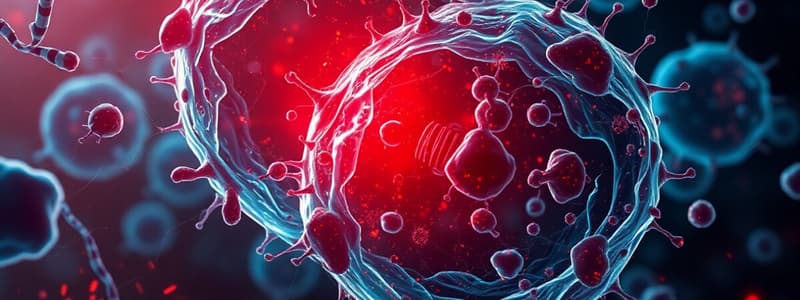Podcast
Questions and Answers
What typically characterizes necrosis compared to apoptosis?
What typically characterizes necrosis compared to apoptosis?
- Programmed cell death with significant cell debris
- Uncontrolled cell death associated with inflammation (correct)
- Controlled cell death with minimal inflammation
- Reversible injury with complete cellular recovery
Which of the following is a reversible change associated with cell injury?
Which of the following is a reversible change associated with cell injury?
- Pyknosis
- Karyorrhexis
- Karyolysis
- Cytoplasmic swelling (correct)
What is a common outcome of cell injury that indicates tissue recovery?
What is a common outcome of cell injury that indicates tissue recovery?
- Fatty change
- Karyorrhexis
- Hypertrophy (correct)
- Fibrosis
Which factor is NOT considered a biological agent causing cell injury?
Which factor is NOT considered a biological agent causing cell injury?
What event is indicative of irreversible cell injury?
What event is indicative of irreversible cell injury?
Which condition is primarily caused by oxygen deprivation?
Which condition is primarily caused by oxygen deprivation?
Which of the following best describes the adaptation response of metaplasia?
Which of the following best describes the adaptation response of metaplasia?
What defines a characteristic of apoptosis in terms of inflammation?
What defines a characteristic of apoptosis in terms of inflammation?
Flashcards are hidden until you start studying
Study Notes
Cell Injury
Definition
- Cell injury refers to the damage caused to cells due to various stressors, leading to functional impairment or death.
Causes of Cell Injury
-
Physical Agents
- Trauma (e.g., cuts, fractures)
- Temperature extremes (e.g., burns, frostbite)
- Radiation exposure
- Electric shock
-
Chemical Agents
- Toxins (e.g., heavy metals, carbon monoxide)
- Drugs (e.g., ethanol, chemotherapy agents)
- Corrosive substances (e.g., acids, alkalis)
-
Biological Agents
- Infectious organisms (e.g., bacteria, viruses, fungi)
- Parasites
-
Nutritional Imbalances
- Deficiencies (e.g., vitamins, minerals)
- Excesses (e.g., obesity, hyperlipidemia)
-
Oxygen Deprivation
- Hypoxia (insufficient oxygen)
- Ischemia (blood supply loss)
Mechanisms of Cell Injury
-
Reversible Injury
- Cellular swelling
- Fatty change
- If stimulus removed, cells can recover.
-
Irreversible Injury
- Apoptosis (programmed cell death)
- Necrosis (uncontrolled cell death)
- Loss of membrane integrity
- Mitochondrial failure
Morphological Changes
-
Reversible Changes
- Cytoplasmic swelling
- Organelle swelling (e.g., mitochondria)
- Fatty accumulation
-
Irreversible Changes
- Pyknosis (chromatin condensation)
- Karyorrhexis (nuclear fragmentation)
- Karyolysis (dissolution of the nucleus)
Types of Cell Death
-
Necrosis
- Uncontrolled and messy
- Associated with inflammation
- Common types: coagulative, liquefactive, caseous, fat, and fibrinoid necrosis.
-
Apoptosis
- Controlled and programmed
- Physiological or pathological triggers
- Minimal inflammation; cellular debris handled by phagocytes.
Outcomes of Cell Injury
-
Adaptation
- Hypertrophy, hyperplasia, atrophy, metaplasia as responses to stress.
-
Repair
- Regeneration: Replacement of damaged cells.
- Scar formation: Fibrosis occurring after extensive injury.
Clinical Significance
- Understanding cell injury aids in diagnosing diseases and developing therapies.
- Identifying reversible vs. irreversible injury helps in treatment decisions.
Cell Injury
- Injury to cells can be caused by a range of stressors, leading to functional impairment or death.
- The main causes include physical agents, chemical agents, biological agents, nutritional imbalances, and oxygen deprivation.
Reversible Cell Injury
- Cells can recover if the stimulus is removed.
- Characteristics include cellular swelling and fatty changes.
Irreversible Cell Injury
- Occurs when damage is too severe for cells to recover.
- Leads to cell death, either through apoptosis (programmed death) or necrosis (uncontrolled death).
- Irreversible changes involve loss of membrane integrity and mitochondrial failure.
Morphological Changes
- Reversible injuries present as:
- Cytoplasmic swelling
- Organelle (e.g., mitochondria) swelling
- Fatty accumulation
- Irreversible injuries exhibit nuclear changes:
- Pyknosis (chromatin condensation)
- Karyorrhexis (nuclear fragmentation)
- Karyolysis (nuclear dissolution)
Types of Cell Death
- Necrosis is uncontrolled and messy, often leading to inflammation.
- Coagulative, liquefactive, caseous, fat, and fibrinoid necrosis are common types.
- Apoptosis is a programmed death pathway, often physiological and controlled.
- Minimal inflammation accompanies apoptosis, with cell debris being handled by phagocytes.
Outcomes of Cell Injury
- Adaptation
- Cells may adapt to stress by undergoing hypertrophy (enlargement), hyperplasia (increased cell number), atrophy (shrinkage), or metaplasia (change in cell type).
- Repair
- Regeneration is the replacement of damaged cells with the same type of cell.
- Scar formation (fibrosis) occurs after extensive injury, involving the formation of fibrous tissue.
Clinical Significance
- Understanding cell injury is crucial for diagnosing diseases and developing therapies.
- Distinguishing reversible from irreversible injury is crucial for guiding treatment decisions.
Studying That Suits You
Use AI to generate personalized quizzes and flashcards to suit your learning preferences.




